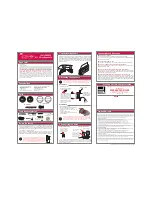
Care of solo
solo is made out of wood, a natural material. Natural materials will always
come to life
when humidity and/or temperature changes. Therefore, solo must be placed in
controlled environment (indoors) and out of direct sunlight. If solo is delivered at a
time when temperature differences between outside and indoors is great, we propose
that solo is kept in shipping boxes for a few hours in the room, so that temperature
and humidity adjust slowly.
A smooth, damp cloth is perfect to dust and clean solo. Use it on the artificial leather,
the wood, terminals and aluminium feet.
Do not use it on the drivers
other than
carefully at the metal basket. A duster may be gently used on the drivers to remove
dust.
WARNING:
Under no circumstances do not use any chemical substances due to risk
of damaging the materials on solo.
Trouble shooting
One channel is not operating
If you switch speaker cables from left-to-right, is problem transferred to the other
channel? If YES, check all interconnect- and speaker cables. If problem still remains,
check electronics.
Imaging is not centric
Are both solo playing? If NO, see above bullet. Is YES, positioning of solo must be
symmetrical in geometry as well as the room must be symmetrical (in terms of
dimension, furniture, etc.).
Some recordings have an image not centre aligned.
Exaggerated highs
Toe in increases the highs and with solos line array ribbon tweeter also listening
position hight is crucial. Small distance to (side) walls with hard, flat surfaces is bad
for sound. Increase distance and treat the walls acoustically.
Exaggerated lows
Is the ribbon tweeter working? If NO, contact your dealer. If YES, then there might be
an acoustical problem or a problem with all to bad amplifier. Try positioning solo with
greater distance from the wall behind them.
Technical Data
Dimensions
1770 x 220 x 680 (Height x Width x Depth [mm])
Weight
85 kg
Crossover
2nd order 2300 Hz.
Impedance
8 ohm. See graph.
Sensitivity:
95 dB/W*m.
System
Ported reflex system.
Frequency response
35
4
-40'000 Hz.
4. In room response much deeper thanks to close boundary effect. 20-25 Hz is common as low frequency
cut off in domestic homes.
by engelholm audio
Revision A
www.engelholmaudio.com
Page 8(11)































